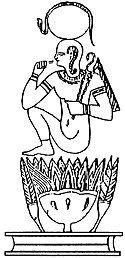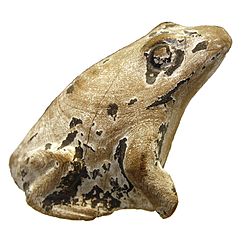The dawn of civilization- Egypt and Chaldaea (1897) (14763536725)
top left: Hehu and Hehut; top right: Amen and Ennit; top far right: Ptah; bottom left: Kek and Keket; bottom right: Nu and Nut; bottom far right: Thoth.
Original caption:
- "Drawn by Faucher-Gudin from a photograph by Béato. C.f. Lepsius, Denkm, iv.pl.66 c. In this illustration I have combined the two extremities of a great scene at Philae, in which the Eight, divided into two groups of four, take part in the adoration of the king. According to a custom towards the Graeco-Roman period, the sculptor has made the feet of his gods like jackals' heads; it is a way of realizing the well-known metaphor which compares a rapid runner to the jackal roaming around Egypt."
Identifier: dawnofcivilizati01masp (find matches)
Title: The dawn of civilization: Egypt and Chaldaea
Year: 1897 (1890s)
Authors: Maspero, G. (Gaston), 1846-1916
Subjects: Civilization
Publisher: London : S.P.C.K.
Contributing Library: Robarts - University of Toronto
Digitizing Sponsor: University of Toronto
View Book Page: Book Viewer
About This Book: Catalog Entry
View All Images: All Images From Book
Click here to view book online to see this illustration in context in a browseable online version of this book.
Text Appearing Before Image:
962. In the Harris M»gic Papyrus(pl. iii. 11. 5, 6, Chabas edition, p. 53) they are called these five gods . . . who are neither inheaven nor upon earth, and who are not lighted by the sun. For the cosmogonioal conception,implied by these Hermopolitan titles, see Maspero, Études de Mythologie et dArchéologieEgyptiennes, vol. ii. pp. 259-261, 381. The relation of the Eight to the Ennead and the god One has been pointed out by Maspero(Mémoire sur quelques Papyrus du Louvre, pp. 94, 95), as also the formation and character of theHermopolitan Ennead (Éludes de Mythologie et dArchéologie Égyptiennes, vol. ii. pp. 257-261,381-383). 3 W. Golénichefp, Die Metternichslele, pl. i., where apes are adoring the solar disk in his bark.This scene is common on hypocephali found under the heads of Grœco-Roman mummies. )48 TEE GODS OF EGYPT. without either characteristic attributes or features;1 or, finally, as four pairs ofgods and goddesses, the gods being frog-headed men, and the goddesses
Text Appearing After Image:
THE HERMOPOLITAN OGDOAD.2 serpent-headed women.3 Morning and evening do they sing ; and the mysterious 1 Lanzone, Dizionario di Mitologia Egizia, pi. xii. : Drawn by Faucher-Gudiu from a photograph by Béato. Cf. Lefsius, Denim., iv. pi. 66 c. Inthis illustration I have combined the two extremities of a great scene at Philœ, in which the Eight,divided into two groups of four, take part in the adoration of the king. According to a customcommon towards the Grseco-Koman period, the sculptor has made the feet of his gods like jackalsheads ; it is a way of realizing the well-known metaphor which compares a rapid runner to thejackal roaming around Egypt. 3 Lefsius, Denltm., iv. 66 c; Mariette, Dériderait, vol. iv. pi. 70; Champollion. Monuments de THE DIFFUSION OF THE ENNEADS. 149 hymns wherewith they salute the rising and the setting sun ensure thecontinuity of his course. Their names did not survive their metamorphoses :each pair had no longer more than a single name, the termi-nation o
Note About Images
Relevantní obrázky
Relevantní články
OsmeroOsmero je označení jedné z verzí staroegyptské tzv. hermopolské kosmologie a současně osmice bohů, kteří v ní vystupují v roli prvotních tvořivých bytostí. Tento mytologicko-teologický koncept vznikl ve významném stejnojmenném náboženském středisku Chemenu, jinak také hlavním centru kultu boha Thovta, v době Staré říše. Od Nové říše byl v souvislosti se svým napojením na Amonův kult rozvíjen také ve Vesetu. .. pokračovat ve čtení





